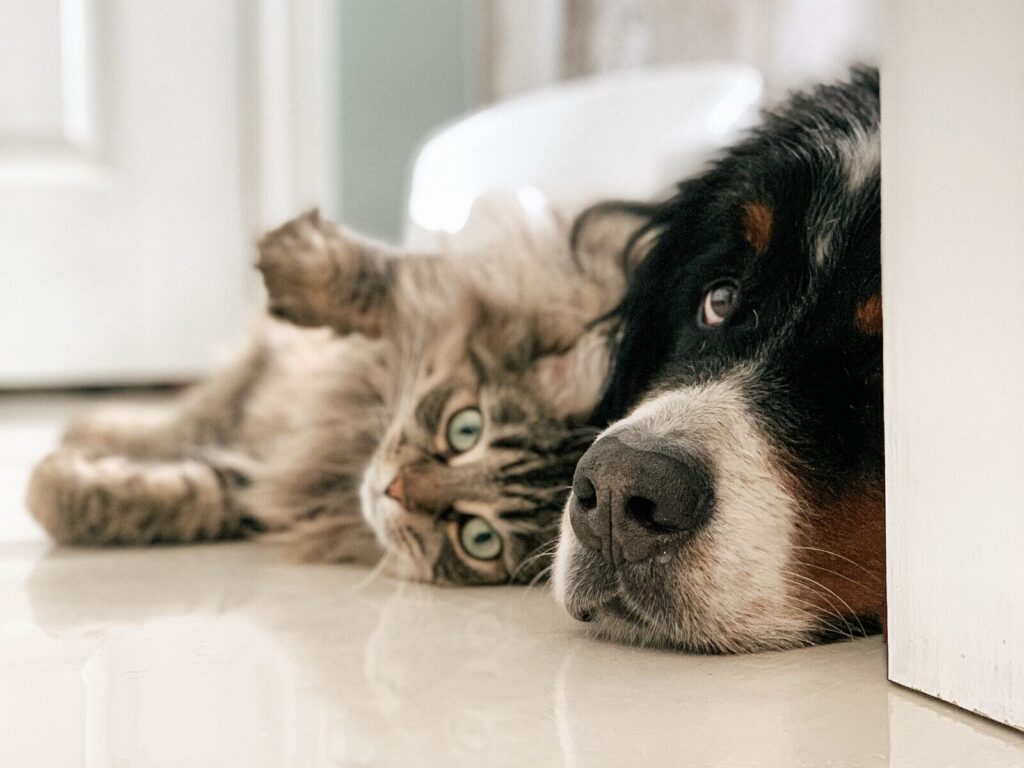Living with a pet is a rewarding experience that can bring joy, companionship, and even a sense of purpose to your life. They’re not just animals, but family members with their own personalities and quirks. Yet, despite the strong emotional bond we form with our pets, there are times when their cat and dog behaviors completely baffle us. One moment they’re cuddling beside us on the sofa, and the next they’re scratching the furniture or chasing their tails in an endless loop. What gives?
Understanding your pet’s behavior is not merely a matter of curiosity; it’s crucial for ensuring their well-being and sustaining a harmonious living environment. Whether you’re a first-time pet parent or a seasoned animal lover, you’ll encounter behaviors that leave you puzzled or even concerned. Misinterpreting these actions can sometimes lead to ineffective or even harmful responses. That’s why it’s crucial to decode the language of your pet’s behaviors, which is often their primary way of communicating with you.
Decoding Cat Behavior
Cats are creatures of mystery, often acting in ways that leave even the most seasoned pet owners scratching their heads. While their independent and aloof nature is part of what endears them to us, it can also make it challenging to truly understand what they are trying to communicate. In this section, we’ll take a closer look at a few common and uncommon feline behaviors, and delve into the fascinating world of what these actions signify.
With insights from veterinarians and feline behaviorists, we aim to decode the enigmatic behaviors of your feline friend, helping you get one step closer to speaking ‘cat.’ Whether you’re new to the joys of cat ownership or a long-time cat parent seeking more understanding, this part of the guide is purr-fect for you.
Scratching Furniture and Other Objects
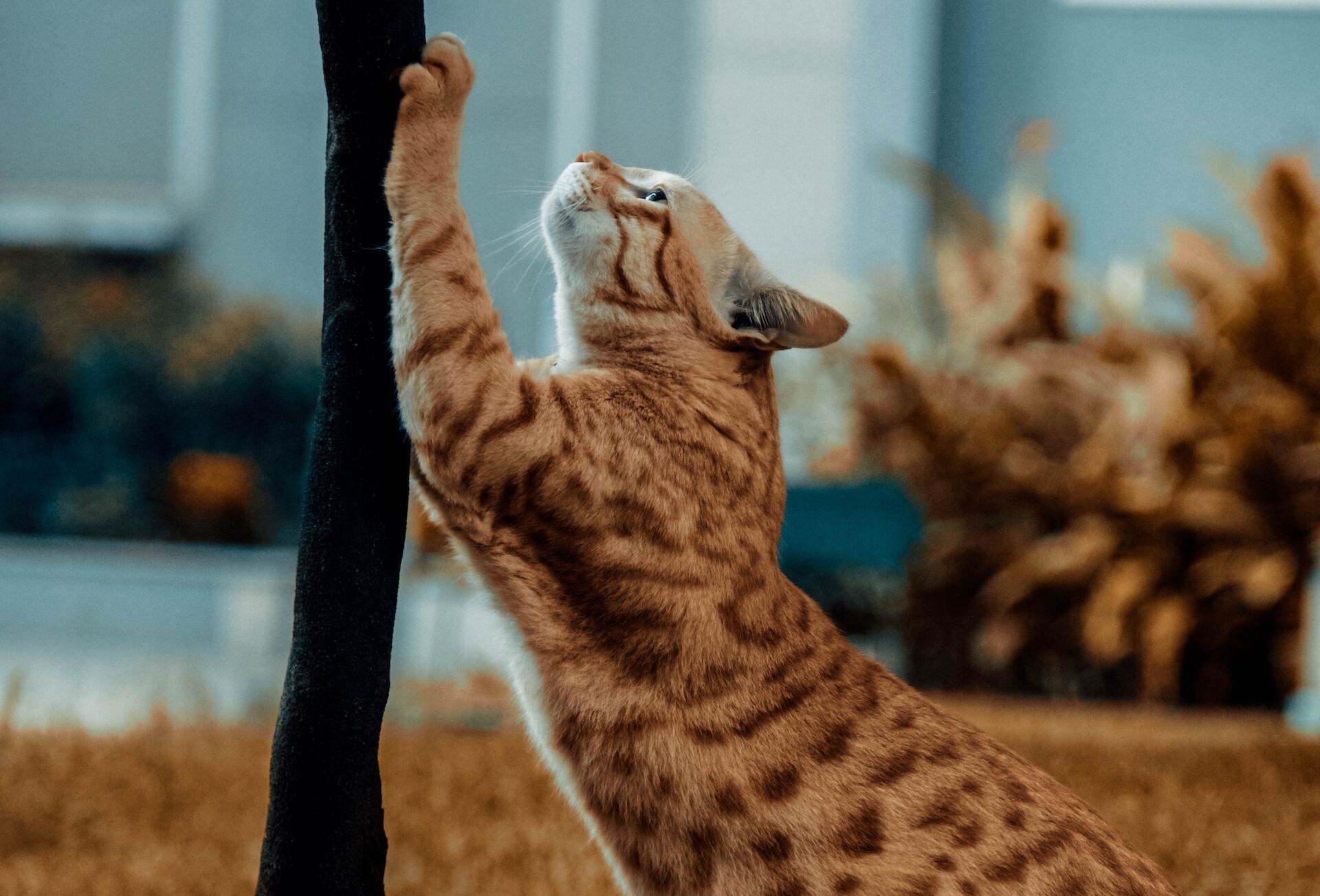
Scratching is more than just a whimsical behavior your cat engages in; it serves several vital functions for your feline friend. Here are the core reasons:
Territorial Marking
Cats are territorial creatures by nature, and one way they establish and maintain their territory is through scent marking. Cats have specialized scent glands located on the pads of their paws. When they scratch a surface, they deposit a scent that is unique to them, effectively saying, “I was here.”
This scent marking acts as a form of communication to other cats that may come into the area, signaling that the territory is already claimed. It’s a visual and olfactory bulletin board that communicates crucial information about the cat’s presence, akin to a “Keep Out” sign for potential intruders.
Nail Health
In the wild, scratching helps cats keep their claws sharp for hunting. In domestic settings, this behavior still serves a practical purpose for maintaining nail health. When a cat scratches, it helps to slough off the outer keratin layer of the nail, revealing a sharper, healthier claw underneath. It’s the feline equivalent of us cutting or filing our nails. Besides, the action of scratching provides a full-body stretch for your cat, engaging the muscles and tendons of their paws, legs, and back. This stretch is particularly beneficial after they’ve woken up from a nap.
Stress Relief
Cats, like humans, can experience a range of emotions, including stress, anxiety, and excitement. Scratching provides a physical outlet for these feelings. The act releases endorphins, which are the body’s natural “feel-good” hormones, offering a form of stress relief and relaxation. Think of it as your cat’s version of kneading a stress ball or punching a pillow when they feel overwhelmed. The mechanical action and the satisfying sensation of scratching can serve as a coping mechanism, helping them to calm down or alleviate pent-up energy.
Solutions to Prevent Unwanted Scratching
While scratching is a healthy and necessary behavior for cats, it doesn’t mean your furniture has to suffer. Here are some effective ways to manage this behavior:
Provide Alternatives
The most straightforward solution is to provide an alternative for your cat to scratch. Cat scratching posts or mats made from materials that cats find irresistible to scratch can divert their attention. Make sure these alternatives are as accessible and appealing as the furniture they are already scratching.
Use Cat Furniture
Multi-level cat trees often come with built-in scratching posts, giving your cat an outlet for their scratching instincts while also providing them with a place to climb and perch.
Training and Positive Reinforcement
Whenever your cat uses the scratching post, reward them with a treat or affection. Positive reinforcement can be an effective training method. Use a firm “no” if they scratch furniture and gently guide them to the scratching post.
Use Deterring Sprays or Tapes
There are sprays available that deter cats from scratching certain surfaces. Double-sided tape can also make the surface of your furniture unappealing to your cat.
Cover Furniture
Furniture covers can serve as a physical barrier between your cat and your furniture. Opt for ones that are scratch-resistant.
Consult a Veterinarian or a Feline Behaviorist
If your cat’s scratching behavior seems excessive or is a sudden change, it may be worth seeking professional advice to rule out any underlying medical or behavioral issues.
By understanding why your cat engages in this behavior and taking proactive steps to guide it, you can save your furniture and also meet your cat’s instinctual needs. The key lies in creating an environment where both your furniture and your cat can coexist happily.
Unpacking Aggression in Cats
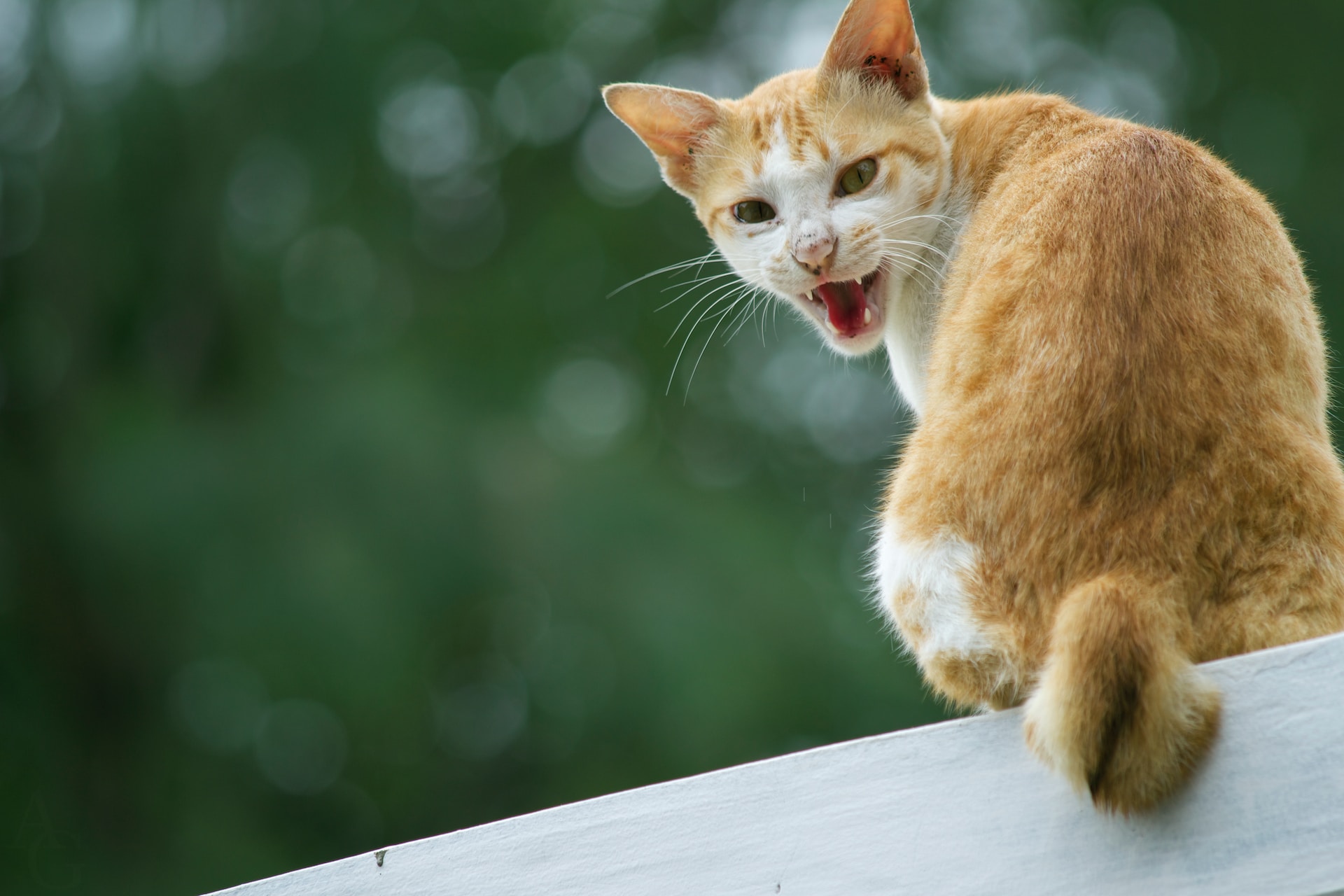
Aggression is a behavior that can be alarming to cat owners, as it is often misunderstood and can cause stress in the household. When a cat displays aggression, it’s important to understand that this is generally a form of communication or a reaction to a particular situation rather than a fixed trait. Here are some common reasons for aggression in cats and potential solutions:
Territorial Aggression
Signs of Territorial Aggression
- Hissing, Growling, and Swatting: These are often the first signs that a cat feels its territory is being threatened.
- Blocking Pathways: A territorially aggressive cat might block doorways or paths to prevent another cat from accessing certain areas.
- Urine Marking: Spraying urine is a way for cats to mark their territory. If a cat starts spraying in the house, it might be trying to establish its territory.
- Physical Attacks: In extreme cases, a cat might attack another cat or even a human if it feels its territory is under threat.
Common Triggers
- Introduction of a New Cat: Bringing a new cat into a home can be a significant trigger, especially if the resident cat feels its space is being invaded.
- Changes in the Environment: Moving to a new home, rearranging furniture, or even bringing in new items can make a cat feel insecure about its territory.
- Outside Cats: A cat might become aggressive if it sees or smells other cats outside, especially near windows or doors.
Managing Territorial Aggression
- Slow Introduction: When introducing a new cat, it’s essential to do so gradually. This can involve keeping the cats in separate rooms initially and allowing them to get used to each other’s scent before they meet face-to-face.
- Provide Separate Resources: Ensure that each cat has its own food bowl, water dish, litter box, and resting place. This reduces competition and potential territorial disputes.
- Environmental Enrichment: Providing toys, scratching posts, and climbing structures can help reduce stress and territorial behavior by giving cats their own spaces and activities.
- Consultation: If territorial aggression is severe or persistent, it might be beneficial to consult with a veterinarian or feline behaviorist. They can provide insights and strategies tailored to the specific situation.
Pain-induced Aggression
Pain-induced aggression in cats is a specific behavioral response that arises when a cat reacts aggressively due to pain or discomfort. Cats, being both predators and prey in the wild, are instinctively adept at hiding signs of weakness or illness. This means that when they do show signs of pain, it can be intense and sudden. Here’s a deeper exploration of pain-induced aggression in cats:
Origins of Pain-induced Aggression in Cats
Cats have evolved to mask their pain as a survival mechanism. In the wild, showing signs of weakness could make them vulnerable to predators. As a result, when domestic cats experience pain, they might not show obvious signs until the pain becomes unbearable or they are touched or handled in a way that exacerbates the pain.
Signs of Pain-induced Aggression in Cats
- Sudden Biting or Swatting: A cat might suddenly bite or swat without warning when touched in a painful area.
- Hissing or Growling: While hissing can be a sign of fear or territorial aggression, it can also indicate pain, especially if it’s out of character for the cat.
- Avoidance Behavior: The cat might avoid being petted, picked up, or might hide more than usual.
- Defensive Posture: A cat in pain might arch its back, puff up its fur, or lay its ears flat against its head.
Common Causes of Pain-induced Aggression in Cats
- Injuries: Physical injuries, such as cuts, bruises, or sprains, can cause pain.
- Medical Conditions: Dental disease, arthritis, urinary tract infections, or other internal issues can lead to discomfort.
- Post-surgical Pain: After undergoing surgery, a cat might be in pain and more likely to react aggressively if touched near the surgical site.
- Mats and Tangles: Long-haired cats can develop painful mats and tangles in their fur, which can cause pain when touched.
Managing Pain-induced Aggression in Cats
- Veterinary Evaluation: If a cat suddenly displays aggressive behavior, especially if it’s out of character, it’s essential to consult with a veterinarian to determine if pain is the underlying cause.
- Pain Management: If the cat is diagnosed with a painful condition, the veterinarian can recommend appropriate pain management strategies, including medications or other treatments.
- Gentle Handling: When handling a cat that might be in pain, it’s crucial to be gentle and avoid areas that might cause discomfort.
- Safe Space: Providing a quiet and comfortable space where the cat can rest without being disturbed can help reduce aggressive incidents.
- Behavioral Consultation: If the aggressive behavior continues even after addressing the pain, consulting with a feline behaviorist might be beneficial to understand and manage the behavior.
Maternal Aggression
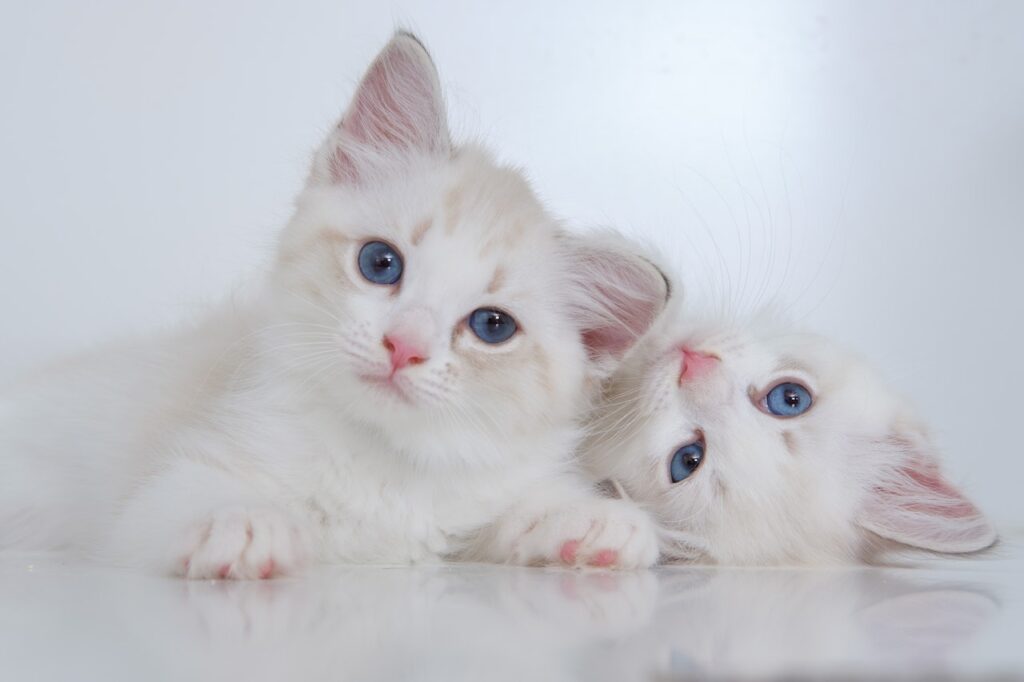
Maternal aggression in cats refers to the aggressive behavior exhibited by a mother cat, primarily to protect her kittens from perceived threats. This behavior is rooted in the instinctual drive to ensure the survival of her offspring. Here’s a more detailed look at maternal aggression in cats:
Origins of Maternal Aggression in Cats
The maternal instincts in cats are strong, and they have evolved to fiercely protect their kittens from potential dangers. In the wild, kittens are vulnerable to various predators, so the mother cat must be vigilant and aggressive when necessary to safeguard her young.
Signs of Maternal Aggression
- Hissing, Growling, and Swatting: When someone or another animal approaches her kittens, a mother cat might hiss, growl, or swat as a warning to stay away.
- Biting: If the perceived threat doesn’t retreat, the mother cat might escalate her aggression by biting.
- Positioning: The mother cat might position herself between her kittens and the perceived threat, acting as a barrier.
- Piloerection: The fur, especially along the cat’s spine, might stand on end, making her appear larger and more intimidating.
Common Triggers of Maternal Aggression
- Handling the Kittens: Especially in the first few days after birth, mother cats can be particularly sensitive to anyone handling their kittens.
- New People or Animals: The introduction of unfamiliar people or animals can be seen as a threat to her kittens.
- Loud Noises or Sudden Movements: Anything that might startle the mother or kittens can trigger an aggressive response.
- Intrusion into Nesting Area: Entering the space where the mother cat has chosen to nest with her kittens can provoke aggression.
Managing Maternal Aggression
- Limit Handling: During the first few weeks, limit handling of the kittens, especially by unfamiliar people.
- Provide a Safe Space: Ensure the mother cat has a quiet, safe, and undisturbed area to care for her kittens.
- Slow Introduction: If introducing new people or animals, do so gradually and under controlled conditions, always monitoring the mother cat’s reaction.
- Avoid Sudden Noises: Try to keep the environment around the nesting area calm and free from loud or sudden noises.
- Consultation: If the mother cat’s aggression seems extreme or if she’s aggressive towards her kittens, it’s essential to consult with a veterinarian or feline behaviorist.
Handling Aggression
Regardless of the type of aggression, it’s important to consult a veterinarian for a full diagnosis, especially to rule out any potential medical causes for the behavior. In some cases, consulting a feline behaviorist might be necessary to properly diagnose and treat the aggression.
Remember that punishment is not a solution for aggression and can make the problem worse. Instead, identifying the root cause and addressing it is the key to reducing aggressive behavior and ensuring a happier, more peaceful relationship with your feline friend.
Overgrooming or Barbering in Cats
Overgrooming, also known as barbering, is a condition where a cat grooms itself to the point of causing skin irritation, hair loss, or even wounds. This obsessive behavior can be a symptom of various underlying issues, both physical and psychological. Here’s how to identify the possible causes and what steps you can take to address them.
Causes of Overgrooming
- Skin Conditions: Allergies, flea infestations, and dermatitis can cause itching and discomfort, leading to overgrooming.
- Pain: Cats may overgroom an area near a painful joint or injury, potentially making the problem worse.
- Psychological Stress: Changes in the home environment, such as moving, the arrival of a new pet, or even changes in your routine, can cause stress, which may manifest in overgrooming.
- Boredom: Lack of stimulation can lead to obsessive behaviors like overgrooming.
- Hormonal Imbalances: Conditions like hyperthyroidism can cause overgrooming.
Solutions to Overgrooming
- Veterinary Consultation: Start by visiting your vet to rule out any underlying medical conditions. Diagnostic tests such as skin scrapings or blood tests may be necessary.
- Allergy Testing: If allergies are suspected, your vet may recommend an elimination diet or allergy testing to identify the culprit.
- Flea Treatment: Make sure your cat is on a reliable flea control program. Even indoor cats can get fleas.
- Pain Management: If a painful condition is diagnosed, appropriate pain relief can stop the need for excessive grooming over the painful area.
- Reduce Stress: Identify and eliminate or mitigate the sources of stress. This could involve creating safe spaces in the home, using feline pheromone sprays, or even anti-anxiety medication in extreme cases.
- Environmental Enrichment: Provide plenty of stimulation through toys, scratching posts, and interactive play. Keeping your cat’s mind occupied can reduce boredom, which may be a factor in overgrooming.
- Behavioral Training: Sometimes, behavioral modification techniques such as clicker training can distract and recondition an overgrooming cat. Consult a qualified animal behaviorist for personalized advice.
- Anti-Anxiety Medication: In severe cases where psychological factors are identified, your vet may prescribe anti-anxiety medication. Always consult your vet for proper diagnosis and medication.
- Regular Grooming: Regular grooming can also help you spot any areas that your cat may be focusing on, allowing you to catch problems before they become severe.
- Soft Paws: Using soft paws or soft nail caps can minimize the damage done during grooming, but this is a short-term solution and doesn’t resolve the underlying issue.
By understanding why your cat is overgrooming, you can take effective steps to treat this behavior and improve your cat’s well-being. Always consult a vet for an accurate diagnosis and tailored treatment.
Another Interesting Read: 40 Pet-Safe Indoor Plants For Plant Parents
Decoding Dog Behavior

Pica in Dogs
Pica is the consumption of non-food items, a problematic behavior that can have serious health consequences for your dog. Whether it’s rocks, fabric, or plastic, the items ingested can cause blockages in the digestive system, lead to poisoning, or cause other severe medical issues. Here’s why dogs may engage in pica and what you can do to address this potentially dangerous behavior.
Why Dogs Engage in Pica
Nutritional Deficiencies
Some dogs resort to eating non-food items when their diets lack essential nutrients, such as minerals, vitamins, or proteins. Just like humans who might crave certain foods when deficient in particular nutrients, dogs may attempt to correct the imbalance by consuming what’s available to them, even if it’s not suitable for eating. However, this can lead to a vicious cycle as these inappropriate items can further harm their gastrointestinal system, exacerbating the deficiency.
Boredom
A bored dog is a dog that’s likely to find trouble. When they have nothing else to occupy their minds and bodies, dogs might find the act of chewing or ingesting non-food items stimulating. It’s an activity that engages their senses, offering smells and textures that might be interesting to explore, even if it leads to negative consequences.
Anxiety or Stress
Just as humans engage in stress-eating or fidgeting when anxious, dogs might consume non-food items as a form of emotional self-regulation. The act might offer a temporary sense of relief or distraction from their emotional discomfort. This is often a dog’s way of coping when they haven’t been taught more appropriate ways to manage their feelings.
Exploration
Puppies, much like human babies, explore the world through their mouths. This natural curiosity can sometimes extend to ingesting non-food items. While exploration is a normal part of development, it can become problematic if it leads to the consumption of dangerous objects. Young dogs haven’t yet learned what’s safe and what’s not, making them particularly susceptible to pica for exploratory reasons.
Attention-Seeking
Dogs are social animals, and they quickly learn what actions get them attention from their human family. If a dog learns that engaging in pica draws immediate attention—whether that attention is positive or negative—they may continue the behavior. Essentially, they may view any attention as better than no attention, reinforcing the problematic behavior.
Medical Reasons
Pica can also be symptomatic of underlying medical issues that may not be immediately obvious to the owner. Gastrointestinal issues like inflammation, parasitic infections, or imbalances in gut flora can make a dog feel compelled to eat non-food items. In other instances, neurological conditions or endocrine disorders like diabetes and thyroid imbalances can also manifest as pica. Therefore, any sudden onset of pica should be promptly evaluated by a veterinarian.
Solutions for Pica in Dogs
Veterinary Check-Up
The first step in addressing pica should always be a thorough veterinary examination to rule out any underlying medical conditions or nutrient deficiencies. Blood tests may be necessary to identify any issues.
Dietary Changes
If the pica is driven by nutritional deficiencies, a diet change might be recommended. Always consult with a vet for appropriate dog food options.
Environmental Enrichment
Provide your dog with plenty of toys, chewables, and engage in regular play and exercise. Keeping your dog mentally and physically stimulated can alleviate boredom that may lead to pica.
Behavioral Training
Use positive reinforcement to train your dog to follow commands like “leave it” or “drop it.” This can deter them from picking up non-food items.
Anxiety Management
Identify and remove stressors from your dog’s environment if possible. Anti-anxiety medication, pheromone diffusers, or calming wraps can also be considered, in consultation with a vet.
Divert Attention
When you notice your dog focusing on a non-food item, redirect their attention to a toy or engage them in a game.
Supervised Outings
Until the issue is resolved, supervise your dog’s outdoor activities to prevent them from eating harmful objects.
Restricted Access
Make sure that non-food items are out of your dog’s reach. Baby gates or playpens can be useful for this.
Professional Help
In extreme cases, consult a veterinary behaviorist for an in-depth analysis of your dog’s behavior and tailored treatment plans.
Understanding why your dog is engaging in pica can be the key to effectively treating this potentially dangerous behavior. Always consult with a veterinarian for an accurate diagnosis and appropriate treatment strategy.
Shadow Chasing in Dogs
Shadow chasing in dogs can be a perplexing and sometimes concerning behavior for pet owners to witness. Whether your furry friend is leaping at shadows on the wall or snapping at fleeting reflections on the floor, understanding the root causes of this behavior is essential for effective intervention.
This behavior may stem from various factors, ranging from high prey drive and boredom to more complex issues like neurological disorders or anxiety. While it may initially seem harmless or even amusing, unchecked shadow chasing can escalate into an obsessive-compulsive action that can have detrimental effects on your dog’s well-being. In this article, we’ll delve into why dogs engage in shadow chasing and offer practical solutions to mitigate this behavior.
High Prey Drive
Some dogs have a naturally high prey drive, which means they are inclined to chase moving objects. While this instinct serves them well in hunting or herding settings, it can become problematic when the object of their attention is a shadow or light reflection. The act of chasing satisfies a deep-seated urge but leaves the dog frustrated when they can’t “catch” the uncatchable.
Boredom
Lack of mental stimulation or physical activity can lead dogs to entertain themselves in any way they can, which sometimes includes chasing after shadows or light reflections. It becomes an outlet for their pent-up energy and a way to alleviate the monotony of their environment.
Neurological Issues
In some cases, obsessive behaviors like shadow chasing can be linked to neurological issues, including compulsive disorder. If the behavior becomes ritualistic and disrupts normal life, there may be more going on beneath the surface. It’s crucial to rule out any medical causes with a comprehensive veterinary evaluation.
Anxiety-Induced Obsession
For some dogs, the act of chasing shadows can become an obsessive behavior fueled by anxiety. They may fixate on the shadows as a way to self-soothe or distract themselves from some other source of stress, but ultimately it often adds to their overall level of anxiety, creating a negative feedback loop.
Solutions to Shadow Chasing
Physical and Mental Stimulation
Keep your dog active and mentally stimulated to minimize boredom-induced shadow chasing. Exercise them regularly and engage them in play or training sessions that stimulate their brain and body.
Environmental Management
Limit exposure to triggering situations, such as specific lighting that creates shadows or reflections. Use curtains or shades to manage natural light and be mindful of artificial lighting conditions that trigger the behavior.
Behavioral Training
Positive reinforcement techniques can redirect the dog’s attention and provide them with a more appropriate outlet for their energy. The ‘leave it’ command can be especially helpful. Training should be performed under the guidance of a certified dog trainer or veterinary behaviorist.
Veterinary Consultation
If shadow chasing becomes an obsessive-compulsive behavior, consult a veterinarian to rule out any underlying medical issues. Medication may be prescribed to manage anxiety or compulsions, and should be paired with behavioral modification therapy.
Mental Health Enrichment
Consider using puzzle toys, food-dispensing toys, or interactive games that engage your dog’s mind and reduce the obsessive need to chase shadows.
As with any behavioral issue, consult with a veterinarian or a qualified behaviorist for a tailored treatment plan that best addresses the specific reason behind your dog’s shadow chasing.
Fly-Snapping Syndrome
Fly-snapping syndrome in dogs is a condition in which the dog appears to snap at non-existent flies or insects, often staring intently before doing so. It’s a behavior that can be concerning for pet owners, especially when it becomes a regular occurrence.
Underlying Medical Causes
Eye Issues
Issues such as cataracts or retinal problems could cause your dog to see “spots” or “floaters,” leading them to snap at what appears to be flies. Schedule a comprehensive eye exam with a veterinary ophthalmologist. Depending on the diagnosis, treatments may include medication, lifestyle changes, or even surgical interventions.
Gastrointestinal Discomfort
Some studies and anecdotal evidence suggest that discomfort in the gastrointestinal tract could manifest in odd neurological behaviors, including fly-snapping. Your vet may recommend a complete gastrointestinal workup, including blood tests and ultrasounds. A change in diet to hypoallergenic or sensitive-stomach formulations might be beneficial, as well as adding digestive enzymes or probiotics to their meals.
Neurological Disorders
In extreme cases, fly-snapping can indicate a more severe neurological disorder such as epilepsy or a brain lesion. Your vet may recommend neurological tests like MRI or CT scans. Medication or other forms of intervention might be necessary based on the diagnosis.
Behavioral Causes
Obsessive-Compulsive Disorder can sometimes manifest in repetitive actions, and fly-snapping can be a symptom. A certified canine behaviorist may recommend a combination of behavioral modification techniques and medication like anti-anxiety or antidepressant drugs to manage the OCD.
Stress or Anxiety
Sudden changes in the environment, loud noises, or an otherwise stressful situation can lead a dog to engage in fly-snapping. Using calming techniques such as pheromone diffusers, weighted blankets, or soothing music can help. In more severe cases, anti-anxiety medication can be discussed with your vet.
Boredom
A lack of physical and mental engagement can lead your dog to find alternative means of entertainment, such as snapping at imaginary flies. Introduce interactive toys and puzzles to stimulate your dog’s mind. Physical exercise, such as regular walks or play sessions, can also help alleviate boredom.
Attention-Seeking
If your dog notices that snapping at imaginary flies grabs your attention, they may start to do it more often. Instead of reacting to the fly-snapping behavior, redirect their attention with an alternative command like “sit” or “paw.” Reward them with a treat or affection when they follow the new command, thereby reinforcing the desired behavior over fly-snapping.
Addressing Fly-Snapping Syndrome typically requires a multi-faceted approach that could involve medical tests, behavior modification, and lifestyle changes. Always consult with your veterinarian for a comprehensive evaluation and individualized treatment plan.
Final Thoughts
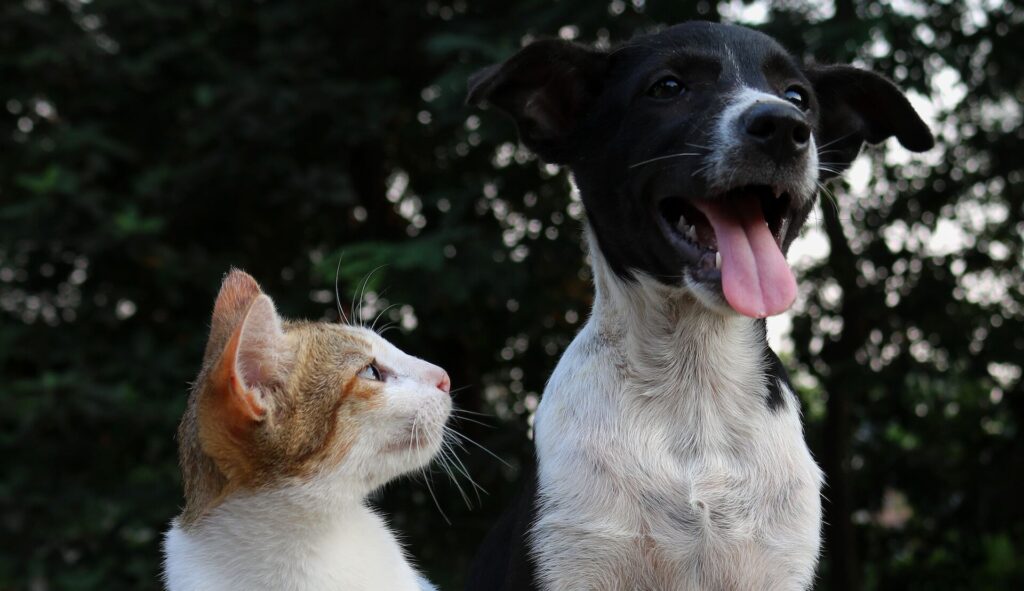
Understanding and interpreting the behaviors of our beloved pets is a journey that requires patience, observation, and a deep sense of empathy. As we’ve explored in this guide, both cats and dogs exhibit a myriad of behaviors, each with its own unique set of triggers and underlying reasons. From the enigmatic actions of our feline friends to the sometimes perplexing habits of our canine companions, it’s evident that these behaviors are often their way of communicating with us, expressing their needs, or coping with their environment.
As responsible pet owners, it’s our duty to decode these signals, ensuring that we provide an environment where they feel understood, safe, and loved. By doing so, we not only strengthen the bond we share with our pets but also ensure their overall well-being and happiness. Remember, every behavior, no matter how puzzling, is a window into the world of your pet. By taking the time to understand, we can make that world a little brighter for them.

